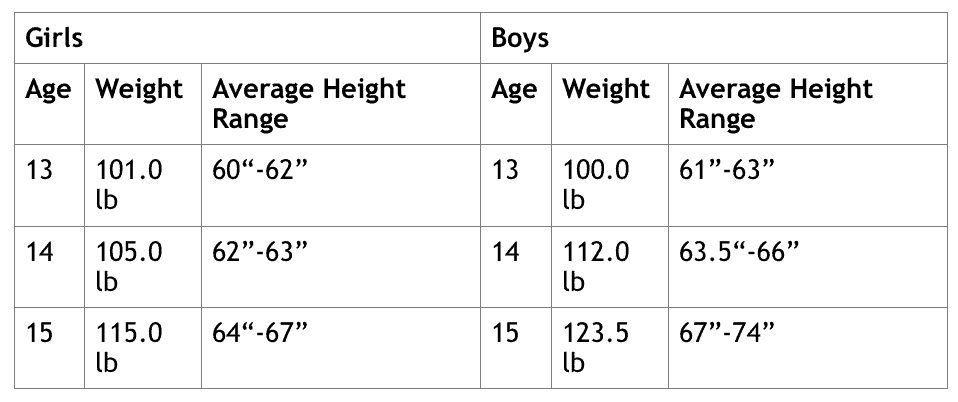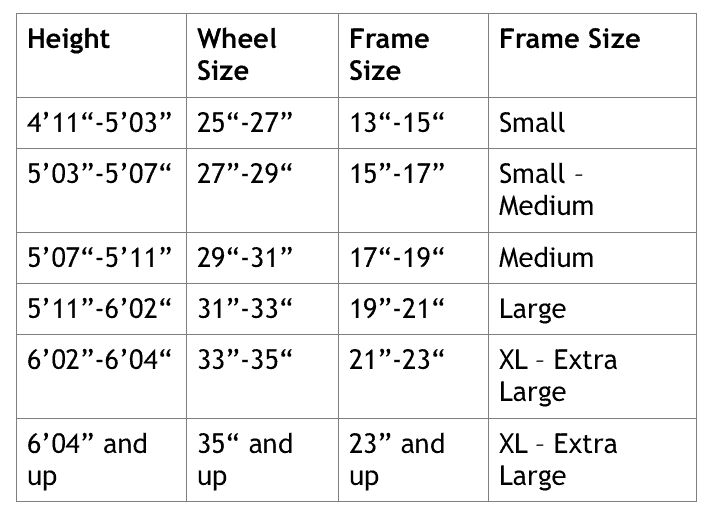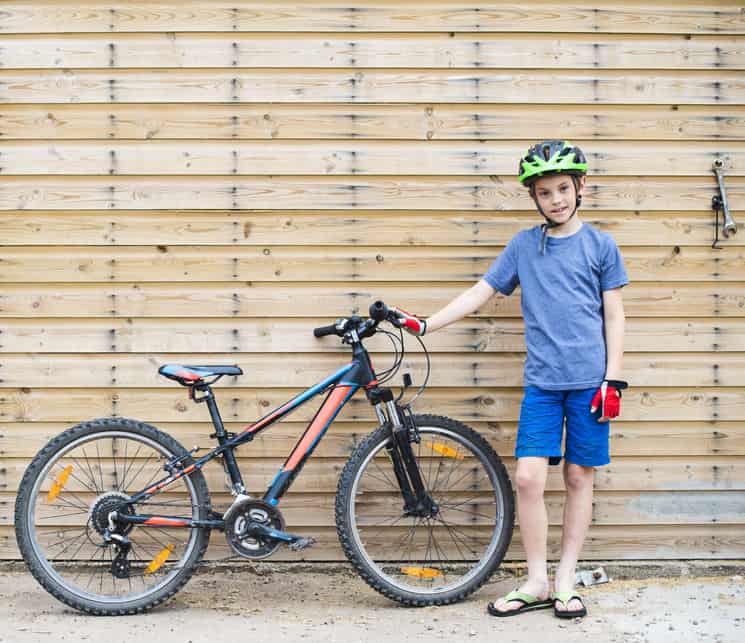Being a teenager is tough, but having a hobby like mountain biking that they can do is a great thing for a number of different reasons. Perhaps you have been mountain biking for a while now and have grown to like this new hobby, but now you’d like to share your passion and skills of mountain biking with a teenager so that they too can ride those trails with you so you can spend some quality time together.
A young teen usually fits somewhere between a small adult mountain bike to a large mountain bike depending on a variety of different things. A young teenager is a great age to get them their own mountain bike since for the most part kids this age are almost if not just old enough to have an adult mountain bike size.
This is one of those tricky times for buying a teenager a mountain bike, though, because these are the years that they are in puberty and could have a growth spurt that could make them outgrow their new mountain bike very quickly.
There are 2 main factors which usually affect a what size of a mountain bike you should get. These are the wheel size and the frame size. However, a few other things to consider is the effective top tube distance, bracket reach, standover height, and the seat height.
These factors will all have to be considered when determining the size of a bike, but bike size alone is perhaps the most important characteristic of mountain bikes that will affect your decisions since the rest can often be adjusted and I will get to those soon enough.
Despite what you may think you can’t just buy a bicycle of any size and hope that it will be the proper height for a teenager. Therefore, here are some things to keep in mind before you make your next purchase.
In order to help you make your decision I will go over a teenager’s average height, and what type of things to look out for in case you think that they might be shorter or taller than average. Once you know the teenager’s height, you can then begin by selecting what type of wheel size or frame size is right for them.
Then I will go over some metrics concerning other aspects of a mountain bike with you so that you can know how to adjust specific parts of the bike to meet the needs of the teenager that the mountain bike is intended for.
Determining Your Teenager’s Height
Matching a bike size to teenager size is something that sounds pretty straight forward, but the problem is that there are many different factors that determine how tall a teenager will be. These factors include: eating patterns and whether a teenager is malnourished or not; sleep cycles and whether a teenager gets enough sleep; exercise regimens and how often they are remaining active on a daily basis; hormone levels and whether they are stable or abnormal; and, lastly, genetics also come into play to determine a teenager’s height.


You may not consider all of these factors when determining the average height of the teenager that you would like to purchase a bike for, but you should at least keep them in mind. Even if the teenager you are buying the mountain bike for is one that you can take the time to measure, these are still important things to keep in mind.
This is because these factors will help to give you an indication of how quickly they might outgrow the bike that you get them and, therefore, can help you figure out just how much money you are willing to spend on getting them a bike of their own.
One key factor that affects height is puberty. Girls usually enter puberty at around 10-11 years old, and this period ends at about 15-17 years old; for boys, 11-12 years is when they begin puberty, and 16-17 years old to is when it ends for them.
If you know the teenager’s age and/or their weight, then you will often be able to get an indication of how tall they might end up. Since girls hit puberty at an earlier age than boys do, this means that they also hit their growth spurt sooner, growing taller and weighing more until around the age of 14 when boys hit their growth spurt most of the time.
Some girls mature faster than other girls, meaning that a girl has the chance of being much taller than what the above chart may indicate, but such a stark difference may only be due to other factors which affect boys, too.
Do Eating Habits Affect A Teenager’s Height?
Yes, eating habits can affect a teenager’s height or growth, but usually not substantially. Mainly this happens if they are consuming a large amount of specific foods which are high in micro-nutrients on a daily basis. This could then hypothetically make them grow more during puberty by providing their bodies with an abundant amount of resources to sustain more growth.
One food that would be a good example of a food like this is mushrooms. When these are sun-dried utilize Ultra Violet (UV) rays in order to synthesize Vitamin D, in the same way that our skin produces Vitamin D when it is exposed to light.
Eating sun-dried mushrooms, taking some Vitamin D2 supplement, or getting out in the sun is an excellent way to synthesize or absorb some of the vitamins necessary to support growth. According to the McGill University Health Center, teenagers who had stunted growth were found to have a deficiency in Vitamin D.

This being the case, if the teenager who you are buying a mountain bike loves to eat mushrooms or is out in the sun all the time, then they are more likely to be of an average height or slightly taller than average.
Kale is another superfood that contains key vitamins and minerals that can stimulate a teenager’s growth during puberty. The Vitamin A in it boosts the absorption of Calcium in the body, and Calcium as well as Vitamin K, helps to make your bones grow stronger and taller.
Moreover, kale is one of the few vegetables that have enough amino acids to be considered a complete protein. If you know a teenager who eats a high volume of kale, then they are more likely to be of an average height or slightly taller than average.
Bananas are another food choice that can affect a teenager’s growth. They contain a large amount of Potassium which plays an important role in strengthening bones and teeth. Like Vitamin A, Potassium increases the absorption of Calcium.
Manganese boosts the metabolism and protects bone health. Eating bananas and kale will keep your bones from thinning and also keep a teenager growing at a normal rate during puberty. Finally, turnips are yet another type of food that can increase a teenager’s height during puberty.
They are grown in the temperate regions and contain vitamins, fiber, and fats. These vegetables help to maintain the constant secretion of growth hormones, and this in turn helps to increase a teenager’s height.
The chances of you finding a teenager that eats all of these foods and plays all day in the sunshine may be rare. However, if you do find one they will either be of an average or, most likely, be above average height.
Poor eating habits can also stunt growth, due to malnutrition. Another thing that you may have never considered is that even if a teenager eats, exercises, and fasts regularly to such an extent that their physique should be at the most optimal levels, and thereby, also their height, if such a teenager is actually short despite all their efforts, then this could be a sign that their body is infested with worms.
Worms can leech the nutrition directly from your diet, and while rare, this would be one of those few times where a worm could be a rational explanation for why someone is short despite their nutrition, exercise, or genetic factors.
Can A Lack Of Sleep Or Exercise Affect A Teenager’s Height?
Yes, but not as significantly as you may think. Interviews on teenagers spanning a few years determined that a lack of sleep caused a lower “puberty score,” but researchers noted that more research needed to be done because they found no correlation between sleep and height.
Those affected with sleep apnea, however, did have a stronger chance of have stunted growth. So, if the teenager that you’d like to purchase a bike for has sleep apnea, then just know that their height might be lower than average even when they stop growing.
Exercise, on the other hand, can definitely affect how tall a teenager can be. In other words, if your teenager is an athlete, then chances are they are taller than average. This is in part still connected to sleep though, since a teen who is really active is much more likely to sleep better at night because they are more tired.
Hormones are also another factor to consider when trying to determine the average height of a teenager. Specifically, I’m talking about Human Growth Hormone (HGH), or Insulin-like growth factor 1 (IGF-1). With not enough of these hormones, the result is stunted growth; with too much, excessive growth.
The amount of HGH produced during exercise or sleep is not even close to matching the levels that a teenager would have during puberty. However, certain exercises like sprinting have been known to increase HGH by up to 530%, and certain dietary habits like fasting have been known to increase HGH by up to 2000%.
If you have a teenager who sprints and/or fasts for extensive periods of time, then they could have an excessive amount of HGH flowing through their bodies, causing them to be much taller than average. There does exist one factor that should make calculating how tall a teenager could be simpler, and that is their genetics.
Our genes are something that each of us inherited from our parents. In essence, if the teenager’s parents are tall then the teenager has a much higher chances of being tall too. If their parents are short, then teenager will likely be short too.
This is all true, as long as the above factors are not significant enough to have a negative or positive effect on their growth and development. To be more precise, genetics have a very strong control over a person’s genes, by a factor of 60-85%.
Therefore, the other 15-40% of the factors that determines how tall you are is something that will be represented by the teenager’s food patterns, sleep, exercise, and hormones. So, for the average teenager where genetics seem to have complete control of their height you can refer to the heights and weights charts for how tall an average boy or girl might be.
How Does One Determine The Proper Bike Size For Teenagers?
By now I am sure you have a good idea of how tall the average teenager is and have used the bike height chart to determine the height of the teenager that you would like to purchase a mountain bike for. The next thing to figure out, is how to tell if that is really the proper bike size for a teenager.
If your teenager already has a lot of experience on a bike, then chances are that it may not matter if you are a few inches off of the perfect height for them, since they might be able to adapt to the incorrect size. However, if the teenager in question is a beginner or has no experience riding bicycles at all, then this next step is absolutely crucial to get right.
If the bike is too large, then it will be too hard for a teenager to control – this in turn, can lead to more crashes. On the other hand, a bike that is too small will cause the teenager will be too uncomfortable while riding on the bike.
Not only that, but they are still growing, and as they grow larger and larger they will only feel more uncomfortable over time with a bike that is too small. 24“ is actually the largest kid’s size in terms of wheel length for a bike, so if your teenager is taller than 5’, then you are better off getting that person a 26” wheeled adult mountain bike.
If your teenager is stuck between 2 sizes, then it’s best to get the bigger size and then go with installing a smaller wheel to make it the right size. This way, as your teen continues to grow you can put the bigger tires on and it will take them longer before they will grow out of it.
What Bike Adjustments Might Need To Be Made?
Ideally, the best way to determine if a bike is the right size for a teenager or not, is to have them sit on it. If their feet are stretched out while sitting and their heels are able to just barely touch the ground, then you have found the perfect sized mountain bike for them.
If the bike is too tall, then their feet will not be able to reach the ground; too short, and not only will the entire sole of their feet touch the ground, but their knees might even start to bend. This last one could cause knee pain in the future if such a bike is selected.
Generally speaking, you will want to have the teenager’s legs to extend from 80-90% of full extension in order to push the pedal all the way down while seated. This allows for more efficient pedalling whether they are going over flat terrain or climbing hills. If their legs are bent too much then you will need to adjust the bike seat or saddle so that their legs have only a slight bend to it.
Adjusting the saddle to a higher position is better for flat ground and hills, whereas for downhill slopes adjusting the saddle to a lower position is better. This is because it lowers the teenager’s center of gravity, thereby providing more control during those descents.
Adjusting the seat is something that is really east to do. Right below the saddle is the seat post, where a quick-release lever is located. You can lower or raise this post to the teenager’s desired height. You may have to use a wrench to do this, maybe even a torque wrench, if a binder bolt is attached to the seat post. Once you’re done, just re-tighten the quick-release lever or binder.
If you are having trouble trying to make this adjustment, then you can often ask a sales associate at the store or a mechanic at a bike shop later on to help you adjust the saddle. You might also want to look for a mountain bike that comes with a dropper seatpost instead.
This type of seatpost allows you to lower or raise the seat with just a push of a button. This feature alone could save your teenager from the frustration of constant adjustments in order to meet the demands of an ever changing height, not to mention the mountain and all of its ups and downs.
One thing that you should do to find just the right sizes is to ask your teenager to get on and start pedalling around a little bit. Make sure to watch their legs as they are doing this. If their knees are too close to the handlebars, or are practically touching the handlebars, then that bike is too small.
On the other end of the spectrum, if the teenager is having a hard time pedalling because they are not able to push the pedals all the way down to complete one revolution, then that bike is too large for them.
Make sure that you also observe whether the teenager is leaning forward or not. Look at how they hold the handlebars. If they are leaning forward too much, then the frame is too big, however, if they appear to be hunched over or their elbows are bent, then chances are that their bike is actually too small for them to ride.
Other Bike Geometry Metrics To Consider
Let us take a closer look into bike geometry, since learning more about the different shapes and bike parts can prove to be an important factor in choosing the proper bike size. To start with the Effective Top Tube, or ETT, is the horizontal distance between the head tube and seat tube.
The ETT measurement can help you to know how long a bike will feel while you are sitting on it. Another part of the is something that is called the reach which is the horizontal distance between the bottom bracket where the gear chain is and the head tube where the handlebars are connected to.
The reach may be a better way to measure length on mountain bikes, because it indicates how long a bike will feel while you are off of the seat. The next thing to calculate is known as the standover height. In order to calculate this, you will need to get the teenager to straddle the bike with the bike in between their legs.
The distance between the bike frame and the top of the inside of their leg is the standover height. The amount of clearance here should be 2 inches at the very least, with 3-5 inches of clearance being preferable. This is because a mountain biker will want to have enough room to dismount their bike quickly and efficiently while they are on the trail.
The angle of the slope of the frame will affect the standover height, so if the angle is too great then this is not necessary to calculate. This is because a large angle means that there will be more as a standover height and the teenager will be practically guaranteed to have good clearance for dismounting their new bike.
Besides the bike metrics themselves, make sure to also consider the build quality of the frame. If the teenager is the type to be reckless and crash a lot, consider getting a metal steel frame that can withstand all of the beating from the mountain side.
An aluminium frame would be a nice second option, and it is also the most common option that is available in stores. If you’ve got the money then you can even invest in a bike that has a titanium or carbon fiber frame.
Titanium in particular is extremely strong and light. Steel, in comparison, is also strong but it adds a lot more weight to a mountain bike. If your teenager is indeed new to this hobby of mountain biking and you suspect that they might crash often and they are relatively weak in terms of physical exertion, then you might want to get them a titanium frame versus the steel frame, since the titanium version should be much lighter for them to carry in case they need to dismount and carry their bike for a hike a bike section on the trail.
Do Not Get A Bike That Is Too Big!
Some people could easily think something like, “Oh, they’ll grow into their new bike eventually.” However, a bike that is too much bigger than it is supposed to be is actually harder to adjust to the correct sizes than a smaller one is. Not only are bikes that are too large harder to adjust for safety and efficiency, but they also discourage the young rider who is only just trying to learn.
Most will brush off the higher amount of accidents that will happen when a teen is given an overly large bike to ride. The problem is that these teenagers will also start to develop bad habits on their new mountain bike as well that will carry over to even when they can fit it right.
Think about it. Say a teenager spends 4 years riding such a monster bike, but then switches to a correctly adjusted bike whose size actually matches their height. They will not be able to ride it safely due to all their bad habits being drilled into them mountain after mountain on their larger bike. A bike that is simply a just little bit larger is fine, just make sure not to take it too far. The idea is to allow the teenager to be able to ride on a mountain in the most safe and efficient manner as possible.

